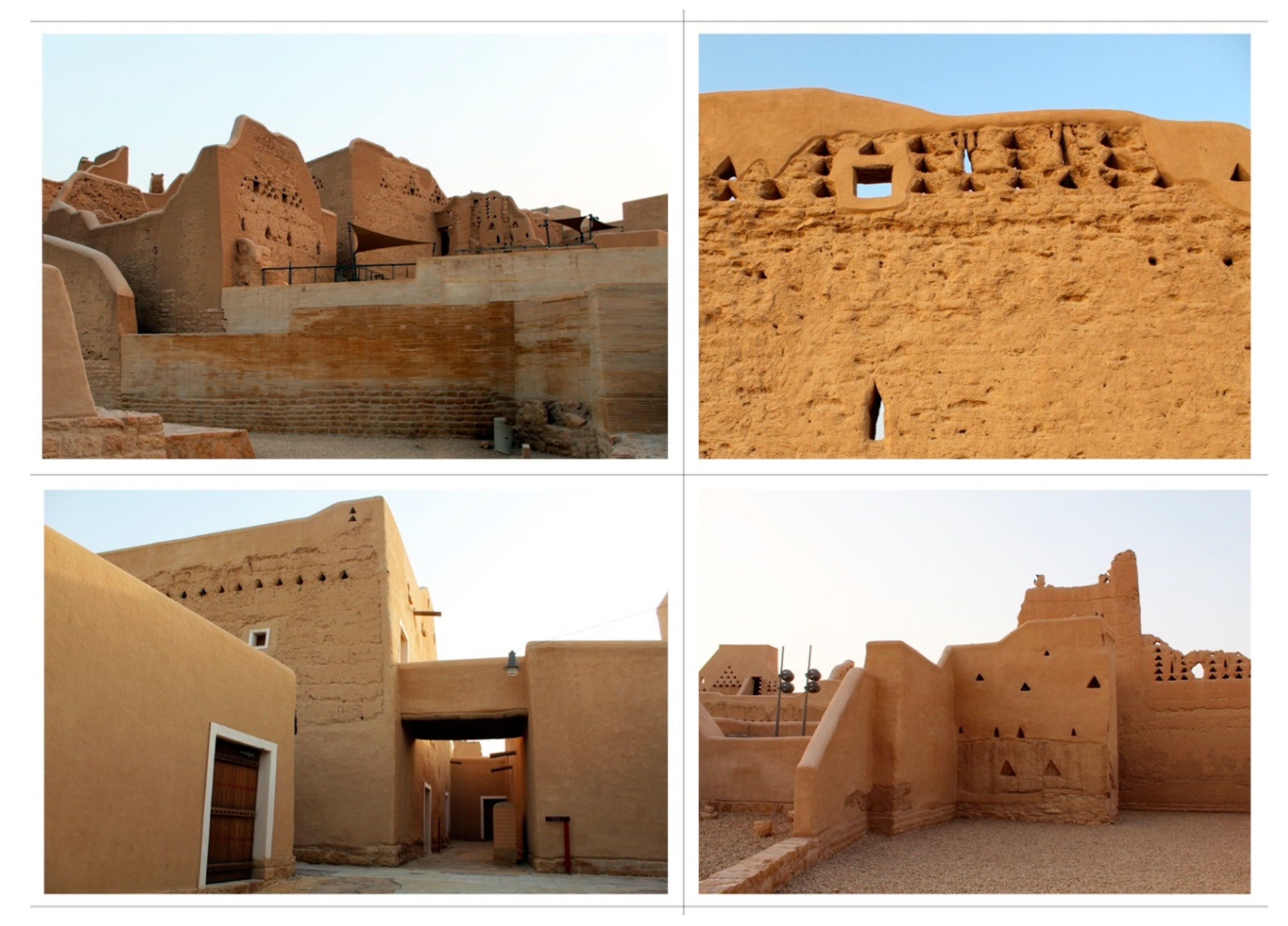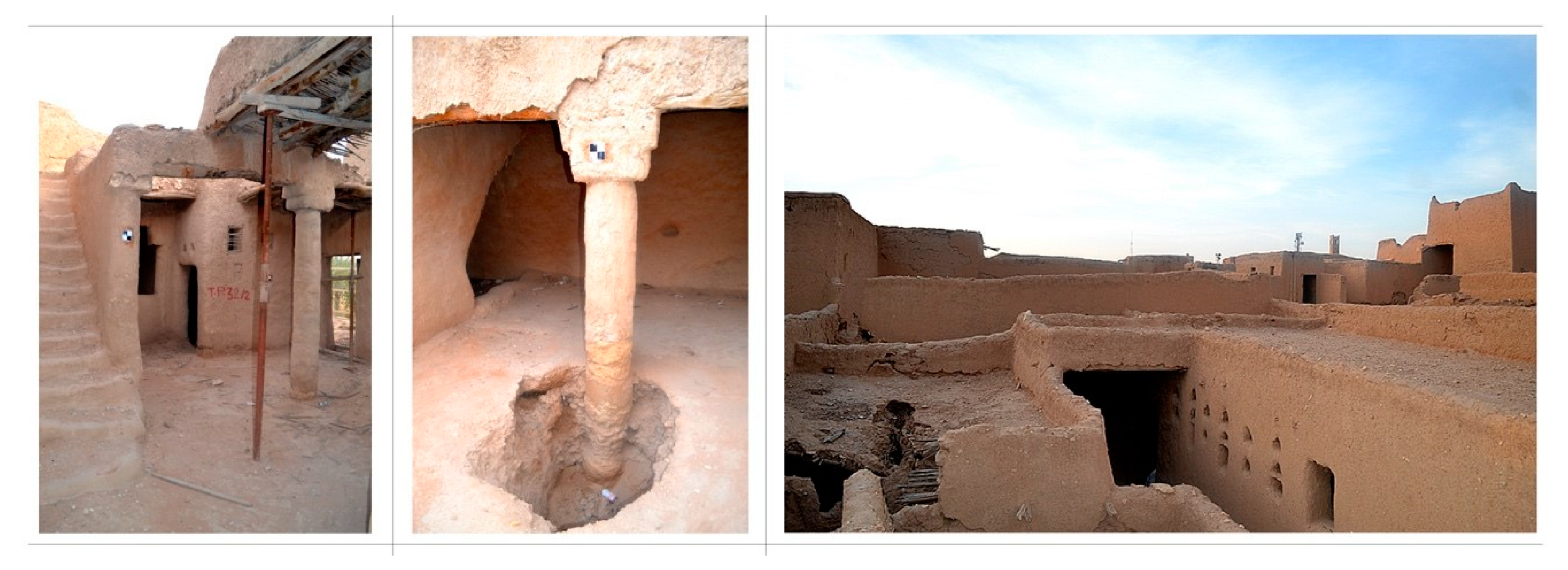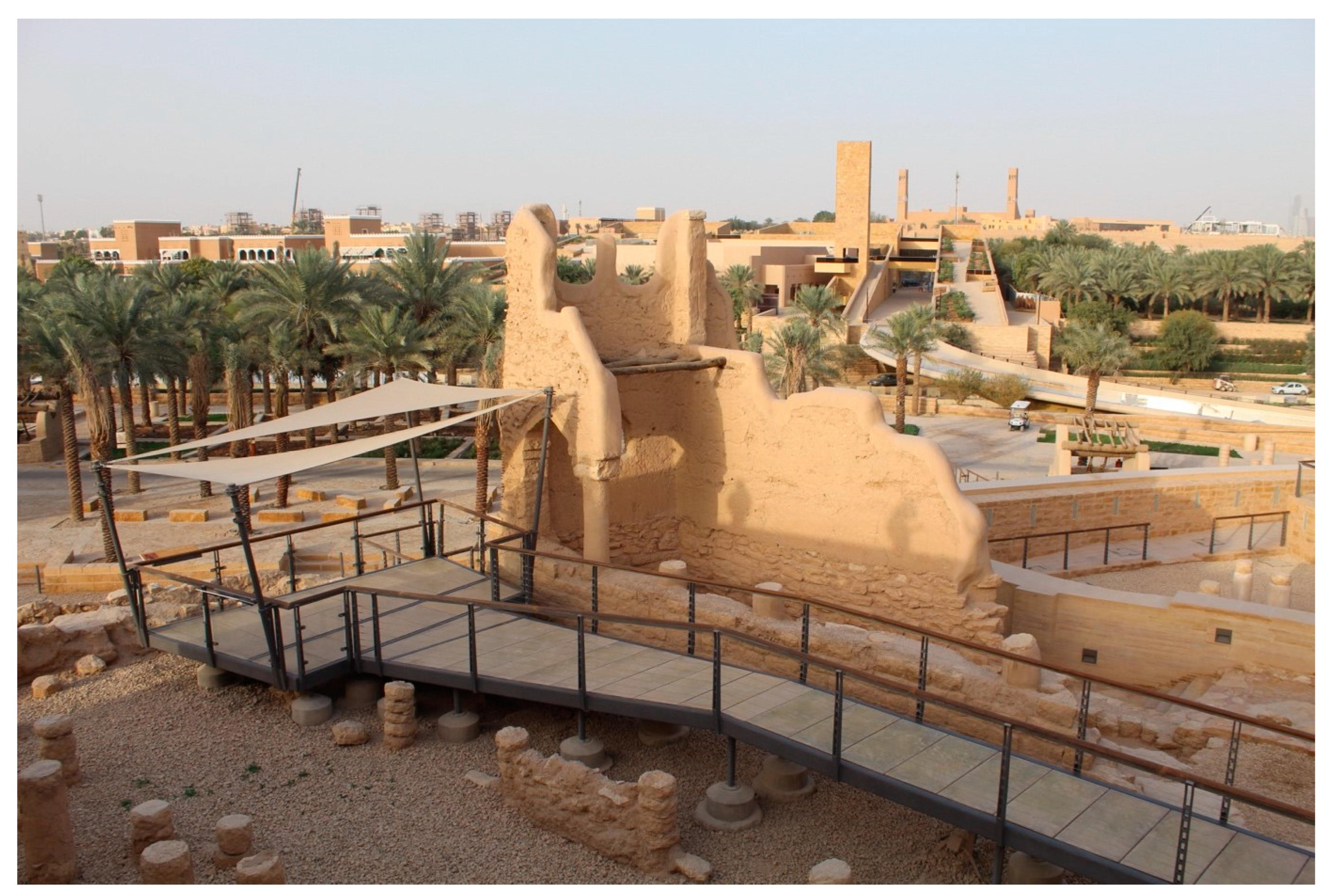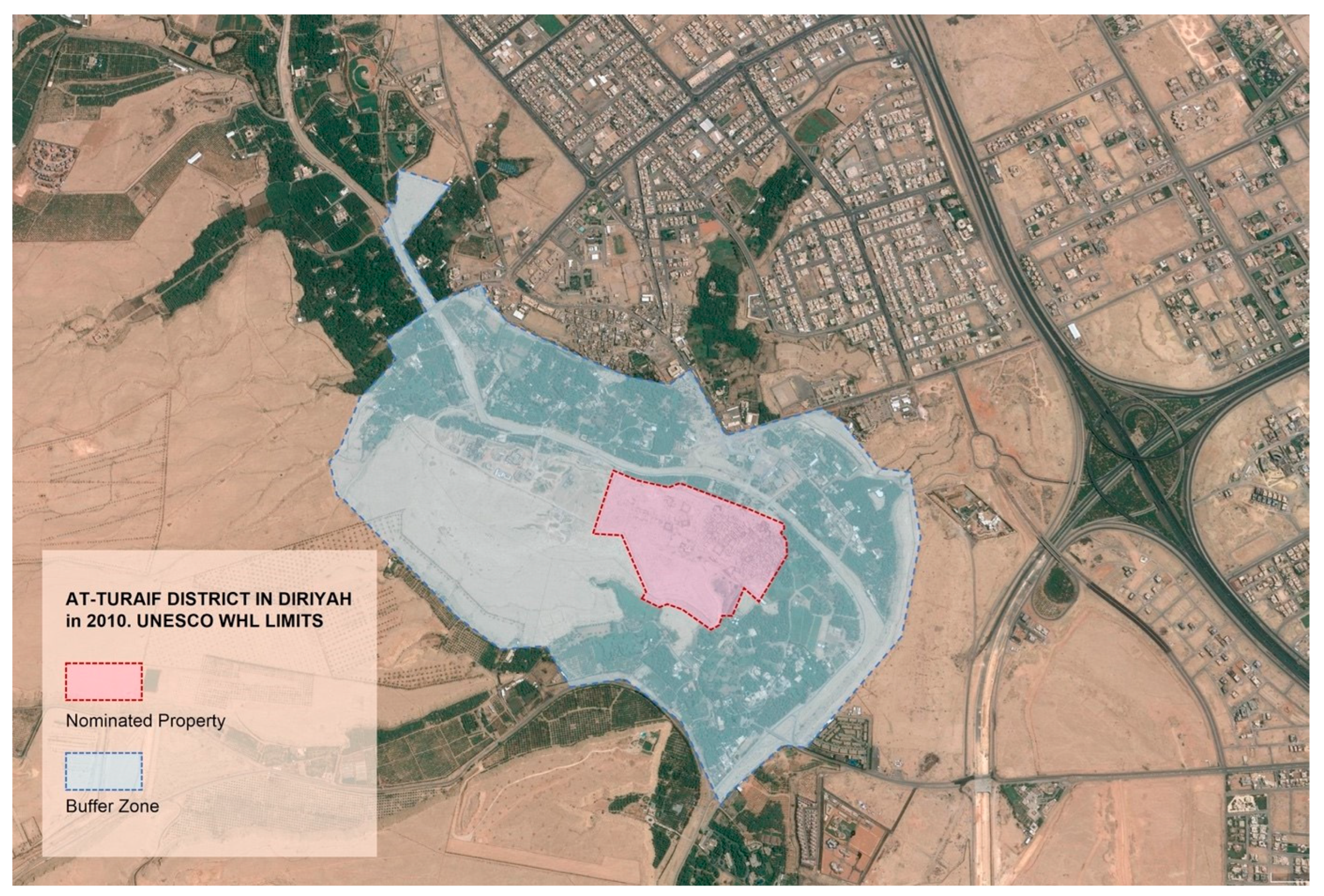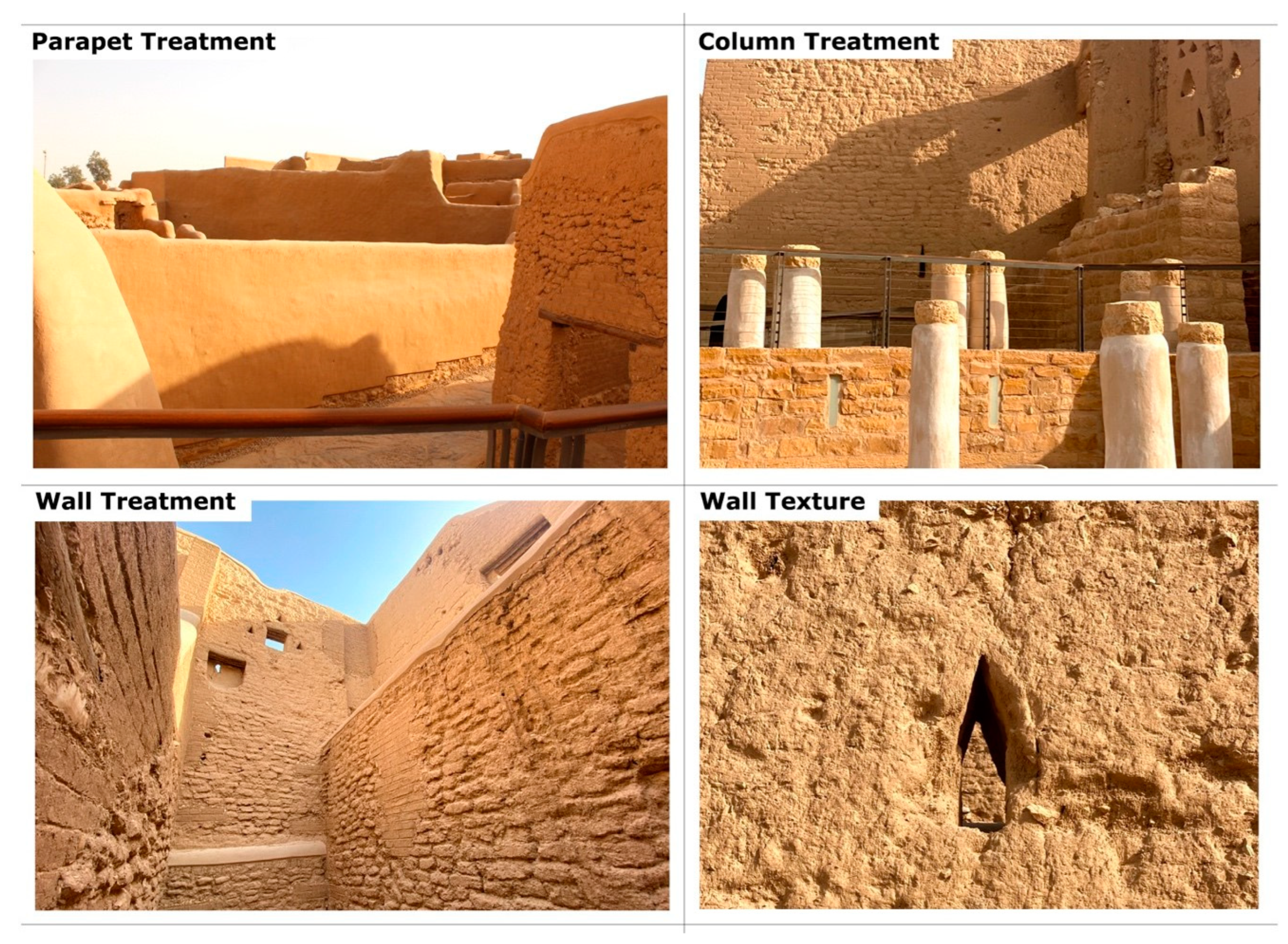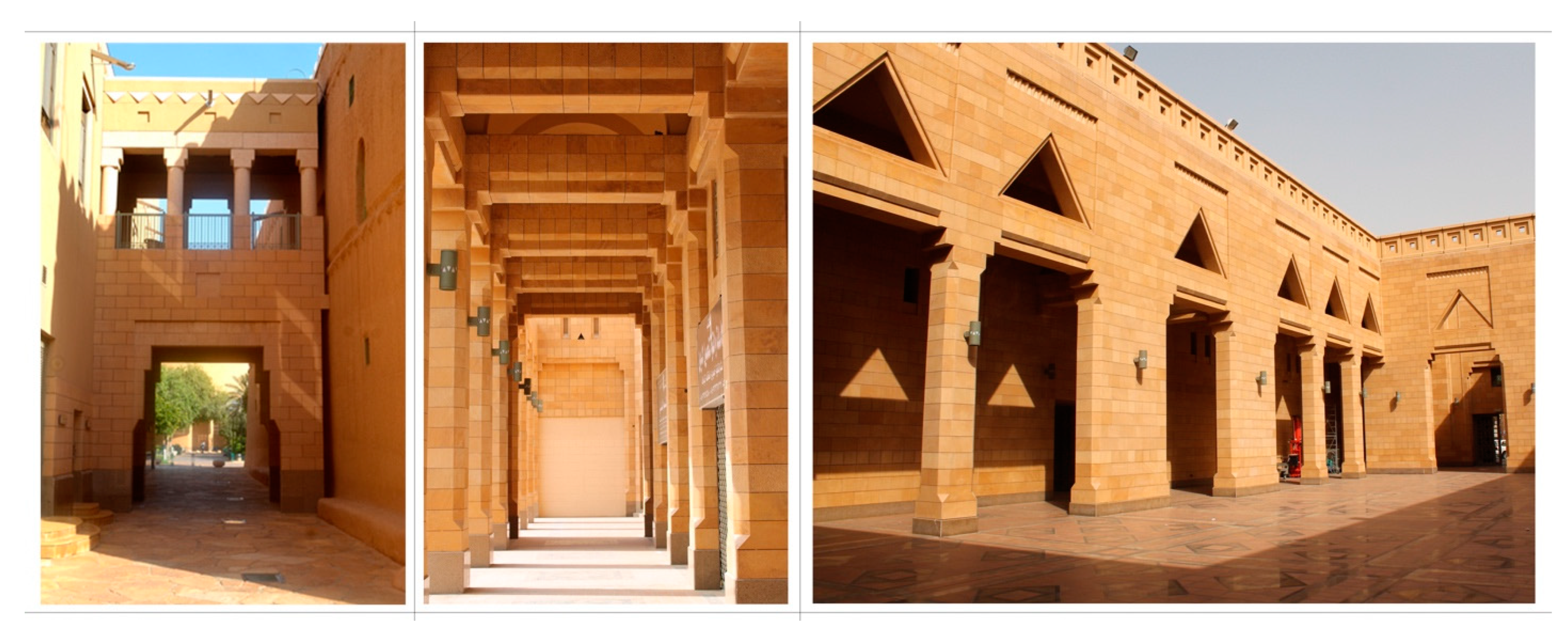1. Heritage Conservation and Development before 2010: From Social Migration and Physical Decay to Ruins’ Protection and Developmental Ideation
According to Al-Othaymeen
[1], Diriyah’s history began as a small village in 1446 and has grown steadily since then. It grew at an exponential rate during the historic alliance in 1744 between Mohammed ibn Saud, the founder of the first Saudi state, and the religious leader Ibn Abdulwahhab. It continued to grow until its demise in 1818
[1]. However, the historic alliance between the two authoritative political and religious entities formed Diriyah’s unique urban settlement and contributed to its distinct built environment
[2]. Diriyah was a significant urban settlement located in the heart of the Najd region, and more specifically, situated in the Wadi Hanifah Valley, where human activities and natural resources collided to form one of the most significant settlements in the Arabic peninsula at the time. Indeed, Diriyah derived some of its distinct characteristics from its location on the Wadi Hanifah Valley, which formed an oasis settlement in the heart of the desert
[3] (
Figure 1).
Figure 1. At-Turaif District in Ad-Dir’iyah and its unique location on the Hanifah Valley and part of Riyadh region.
Historically a separate town, Diriyah is now an integral part of Riyadh, the capital of Saudi Arabia. In addition, it features a sizable urban fabric that illustrates the distinctiveness of Najdi architecture and urban design uniqueness. It is a political power in the middle of the Arabian desert and has been from many generations. It is also a living example of how people can adapt to living in a very hot and dry environment (
Figure 2)
[4][5].
Figure 2. The architecture of At-Turaif district represents authentic Najdi style. Source: Authors.
The Historic Diriyah district is significant because it was the capital city of the first Saudi State in the 18th century (founded in 1727)
[1]. It had a significant political importance at that time because critical historical events occurred in the district that illustrates Historic Diriyah’s significant value today and shaped many aspects of Saudi Arabia’s future.
The challenge faced by Historic Diriyah is in the migration of its inhabitants to new settlements
[6]. However, this is a challenge faced by other historic areas in Saudi Arabia as well as many traditional settlements around the world. In Saudi Arabia, the oil boom era during the 1960s and 1970s encouraged most people to move out of their traditional houses to inhabit new areas built with new construction materials in search of a more contemporary lifestyle
[7]. In fact, there is evidence that in many dwellings in central Riyadh, landlords of traditional houses built long ago applying cement material onto the outer surfaces, i.e., the
façade, of their mud-brick houses to project an image of progress, an adaptation to preferences of tenants for a more modern design. This action clearly indicates a time when local communities favored modern buildings and infrastructure over historic homes and neighborhoods. These behaviors are echoed by global trends worldwide. For example, during the last third of the 20th century, the abandonment of traditional rural dwellings, people’s migration to larger cities, and the adoption of modern construction techniques irrelevant to the architectural heritage and to make their houses look attractive have been frequent in many European countries
[8]. In fact, architects and planning authorities in Saudi Arabia had a generally negative view of traditional houses and historic districts during the oil and economic reform era. They turned away from these old buildings and preferred more modern ones, thinking of them as backward and unworthy
[9].
Eventually, inhabitants of Historic Diriyah moved out, in search of a more modern lifestyle and new opportunities. As a result, Historic Diriyah was left to decay, becoming, in effect, a standing ruin, having only nostalgic and memory values
[10]. In 1973, Saudi Arabia issued a royal decree to preserve Historic Diriyah and restore its heritage buildings, which is regarded as the first conservation effort on Historic Diriyah. Then, in 1976, it was designated as an ‘antiquity’ under the protection of the antiquities act 26M (1972), which resulted in the restoration and reconstruction of some monuments
[11]. However, before the inscription of Historic Diriyah to UNESCO’s WHS in 2010, the Arriyadh Development Authority (ADA), designed and implemented two separate conservation and protection plans
[12][13]. The ADA was working on the conservation and development of Historic Diriyah before these two efforts. In 1986, the ADA proposed a development study that in its first phase included a future directive plan to guide development in Diriyah, as well as a specific proposal for the development of historic Diriyah. Moreover, the proposed study assumed a tentative urban design for the historic area in Diriyah, and included aspects of preserving the built heritage, preserving the historic monuments, and improving public amenities.
The second phase of the ADA emphasizes two major goals: preserving and improving Diriyah historic attributes, and prescribing services and amenities that contribute to this goal. Furthermore, the second phase includes restoration and rehabilitation plans for historic areas that take into account heritage values (see
Figure 3 and
Figure 4)
[12]. The desired outcome of the project, on the other hand, includes parameters for protecting the site as well as specific steps that can be taken to delay the deterioration process. As a result, this development plan has not yet been fully implemented; rather, it was a startup plan that led to significant development plans.
Figure 3. Model of the Historic Diriyah showcasing the conservation working area. Source: Authors.
Figure 4. Example of the building restoration and rehabilitation process. Source: Authors.
Although the ADA attempted to propose plans at this early stage to preserve the physical structures and environment as well as developing urban design solutions for reusing the historic site, these efforts fell outside the scope and guidelines established for WHS, but the ADA’s actions were an important step in preparing Historic Diriyah for inclusion on the list of UNESCO WHS.
In 2000, the ADA again launched its ‘Diriayh Development Program’ which included status quo studies, a schematic concept design, identification of public-private roles, and an overall implementation plan. Moreover, the Diriyah development program consisted of several sub-programs: (1) an urban development program, (2) an environment development program, (3) a heritage and cultural development program, (4) a socio-economic program, and (5) a public amenities program. Furthermore, this program considered socioeconomic aspects, the urban environment, connectivity between Diriyah and Riyadh city, and the protection and conservation of Diriyah’s heritage assets. The conceptual plan, on the other hand, included a vision that took four dimensions into account: (1) human-centered development; (2) a recognized international heritage; (3) a historic national depth linked to the establishment of the Saudi State; and (4) a local dimension that provides best public services and amenities to promote a better place (Figure 5).
Figure 5. A view of Diriyah district and Bujairi quarter development. Source: Authors.
Renovating streets, neighborhoods, or towns with a significant historical heritage necessitates a comprehensive approach as well as a thorough understanding of the historical facts and values
[14]. At this point, the ADA realized that in order to develop historic Diriyah and the later-developed traditional neighborhoods of Diriyah, they needed to see it in a broader context in order to elevate the Diriyah site’s development output. As a result, the ADA acknowledged that developing only the historic Diriyah is insufficient and that it must be part of a comprehensive plan that includes the entire town of Diriyah in order to achieve the ambitious goal of becoming a cultural tourist destination
[15]. Concerns were raised when it was discovered that the surrounding areas and neighborhoods were jeopardizing the quality of the heritage site in terms of sustainable urban development integration. As of this point, the town of Diriyah appeared unhomogenized between its various areas, lowering the quality of the heritage site. As a result, the foundation of development consisted of a comprehensive plan for the city of Diriyah that included historic areas, old neighborhoods, and modern neighborhoods. Furthermore, to ensure the development’s continuity, the ADA encouraged development-driven activities and local community participation in the development phases. Finally, the ADA established private partnership guidelines that allowed the private sector to participate in the various phases of the program
[13].
Cultural heritage is being currently broadened in order to include natural environment and vegetation resources and assets among its values and key factors
[16]. Despite the fact that the ‘Diriayh Development Program’ encouraged urban and environmental developments, Al-Nashwan
[17] has identified several urban and agricultural impacts resulting from the urban and agricultural development at the intersection of Diriyah and the Hanifah Valley. These urban and agricultural developments have an impact and change on the environment of Hanifah Valley. This shift is attributed to the lack of policy and regulation, as well as the competitiveness of carrying out economically driven projects and developments. On the one hand, urban development in the form of annexation of neighborhoods, construction of road networks and bridges, the removal of soil, littering, and pollution have degraded the Valley environmental settings as well as its streamways. The development of agricultural lands and their structural boundaries, on the other hand, have contributed to the deterioration of the Valley’s streamways
[17].
Economically, Historic Diriyah at the time that it was a standing ruin did not generate any income or provide for the local economy even though it was a place of history and importance. On the contrary, the district was an expense to maintain, even at the minimum requirements of conservation and preventive interventions. This economic burden is due to local communities moving out of the district and becoming distant, hence not participating in the site’s major activities. The economics of the site were neither contributing to the gross income of the government, nor to the local communities, despite the agenda proposed in the ADA’s 2000 Diriyah development program.
The first period indicates care and attention towards Historic Diriyah due to its significance and association with the establishment of the Saudi State. This care and attention led to major studies, master plans, as well as protection and restoration activities which were reflected in the Diriyah Development Program. At this stage, protection of the remaining ruins, slowing down the rate of decay, and proposals for development plans were essential steps in preparation for the UNESCO WHS inscription. The enhancement of heritage elements related to a city or country’s history is a global trend. These assets are used by governments not only as tourist attractions, but also to reinforce collective identity
[18][19]. Therefore, the Saudi government envisioned Historic Diriyah to be a source of the country’s national identity and a recognized international travel destination, and this vision was confirmed by Historic Diriyah’s UNESCO inscription in 2010.
2. Heritage Conservation and Development after 2010 until 2017: WHS Inscription and Implementation Plan
During this time, Saudi Arabia expressed a strong desire to have Historic Diriyah listed as a UNESCO WHS. Around that time, significant progress was made in the heritage field, resulting in the activation of numerous heritage projects throughout the Kingdom, including the submission of multiple files with Outstanding Universal Value (OUV) to the UNESCO WHS. It was a period when Saudi Arabia expressed a keen interest to reclaim its national pride and identity through its heritage. The first site ever to be listed as a WHS in Saudi Arabia was the Hegra Archaeological Site in Al-Ula, which successfully inscribed on the UNESCO WHS list in 2008. Consequently, Saudi Arabia was encouraged to pursue further additions to the list and to convey to the international community an image of progress regarding its cultural heritage sector. As a result, Historic Diriyah was inscribed by UNESCO in 2010 and had a positive impact on the Saudi Arabian heritage sector (Figure 6). The district was proposed because of its historic connection to the establishment of Saudi Arabia, as well as its potential to project the country’s national pride and commemorate the earlier Saudi states.
Figure 6. At-Turaif District in ad-Dir’iyah property boundaries and buffer zone.
Being listed in the UNESCO WHS required prerequisite measures that were demonstrated in the first period. The ADA, along with other international, national, and local stakeholders, prepared the required documents for the world heritage review committee. At this stage, the ADA had taken major actions toward the site’s archaeological excavations and artifacts discoveries
[20], protection and conservation, and management and implementation planning that included both renovation and adaptive reuse proposals
[15][21]. The ADA has successfully set up the protection measures along with the conservation plan, even though the activation plan for tourism purposes remains inactive until today.
According to Bendakir
[22], the conservation measures and guiding principles used in Historic Diriyah aligned with the Operational Guidelines for the implementation of the World Heritage Convention
[23], that is:
-
Being non-intrusive: to ensure old and new structures are compatible; intervention strategies should be minimal, distinguishing between old and new additions and repair.
-
Ensuring reversibility: conservation interventions should be reversible without damaging the original structure.
-
Use of original materials and traditional techniques.
Historic Diriyah had several major issues and challenges in terms of risk assessment. For example, the site is vulnerable to both human risks (migration and abandonment of historic buildings, a lack of cultural heritage specialists, and mechanical vibrations) and natural risks (rainfall, insects, animals, and temperature)
[24]. Al-Tokhais and Thapa
[25] identified several issues related to the site condition, such as: the site consists of a fragile structure made of mud structural material; the site’s inscription is attracting worldwide attention, and tourism pressure soon will be an issue; and urban development pressure poses certain risks to the site (
Figure 7). In addition, the site faces major challenges such as seasonal flooding, loss of authenticity, as well as a loss of traditional agricultural practices and irrigation systems.
Figure 7. Samples of At-Turaif conservation treatment and construction. Source: Authors.
The Saudi authorities invested in significant amounts of conservation work during this period due to the need for regular maintenance of the mudbrick material (which rapidly degrades), as well as the requirement of UNESCO that the Kingdom provide an annual conservation report. Concerning the aforementioned conservation activities, Historic Diriyah and its surroundings have experienced a major turning point in conservation management activities which has led to a shift in focus from protection to various intervention strategies. For example, intervention strategies such as restoration, rehabilitation, and adaptive reuse activities with modern additions, new structures, and new projects’ activation are widely implemented within the district
[21]. Specific examples of investment in modern additions and new structures include additions of new structural bridges, modern galleries, exhibition space, museums, long catwalks, and necessary functional facilities (e.g., a visitors’ center) (
Figure 8). In particular, the visitors’ center has implemented new design features, projecting a contemporary traditional architecture that responds to modern needs and requirements
[26]. These new open-air museum implementations are part of the tourism planning goals that Historic Diriyah is promoting
[24].
Figure 8. The new additions and installments inside At-Turaif district. Source: Authors.
Historic Diriyah demonstrates a spectacle of a unique urban settlement and an environmental setting of Wadi Hanifah which projects an interaction between human and its environment. These urban settlement and environmental values underline the WHS’ criteria V which in Historic Diriyah states:
“The site of at-Turaif District in ad-Dir’iyah illustrates a significant phase in the human settlement of the central Arabian plateau, when in the mid-18th century Ad-Dir’iyah became the capital of an independent Arab State and an important religious centre. At-Turaif District in Ad-Dir’iyah is an outstanding example of traditional human settlement in a desert environment”.
In terms of environmental upgrades, the ADA has conducted a massive rehabilitation plan for the Hanifah Valley Wetlands where Historic Diriyah is situated. The Hanifah Valley Rehabilitation Project is the recipient of the Aga Khan Award (2008–2010 cycle). Not only has the Hanifah Valley Rehabilitation Project improved Historic Diriyah, but it has also facilitated the launch of the Hanifah Valley Urban Code in which urban codes and regulations apply to the Hanifah Valley jurisdictions that overlap with Historic Diriyah
[28] (RCRC is “Royal Commission for Riyadh City,” which is the new name of ADA “Arriaydh Development Authority.”).
Historic Diriyah has gained some destination prominence after its inscription to UNESCO and received more site visits and appreciation from both local inhabitants as well as international visitors. However, its role remains limited to serving as an open-air museum showcasing early examples of the architectural and urban patterns of the old Najdi traditional style with no additional usage. During this period, Historic Diriyah has not experienced any major development, other than the development in the Al-Bujairi area which is a nearby neighborhood close to the designated At-Turaif district
[29] (
Figure 9).
Figure 9. The architecture of Al-Bujairi Quarter. Source: Authors.
The social aspects of Historic Diriyah remained relatively constant at this stage, despite the gradual change in the population of Diriyah city and its new neighborhoods. However, at this point, the UNESCO inscription had no effect on the district’s social aspects, and the development activities required as a result of the UNESCO inscription had not yet been incorporated into Historic Diriyah conservation and development plans. This is because the Saudi government owns the site’s historic structure, making the social aspects not a focus because the site is not habitable. In the same vein, the funding requirements for conservation and development were high, as Historic Diriyah demanded a massive budget for implementing necessary conservation and intervention strategies. Due to the low level of economic activity during this time, the site was temporarily closed while plans were developed and implemented. The plans resulted in Historic Diriyah experiencing massive change led by the Diriyah Gate Development Authority’s new master plan (The master plan is part of the USD 18.5 billion budget to develop Diriyah into a tourist destination (e.g., new boutiques, hotels, fine dining restaurants)).
3. Heritage Conservation and Development after 2017: From Conservation Activities to Major Tourist Destination and an Exemplary Project for the Saudi Heritage Sector
Not until Saudi Arabia’s 2030 Vision and Quality-of-Life Program was unveiled in 2016 and 2017, respectively, did it become clear that it was a high priority of the Saudi government to diversify the economy and enhance citizens’ well-being
[30][31]. With its rich history, architecture, and political significance, as well as its inscription to the prestigious UNESCO list, Historic Diriyah’s significance has grown exponentially and the need for its development became essentially central. Historic Diriyah has taken a major step forward with the establishment of the Diriyah Gate Development Authority (DGDA) and the announcement of a USD 18.5 billion phase one financial plan to develop the district and promote the site as the “Jewel of the Kingdom” and a fine international tourist destination (
Figure 10).
Figure 10. Change overtime from past to present showing the increase of size and future developments.
The At-Turaif District and its immediate surroundings will undergo a massive facelift by 2025 as part of DGDA’s massive makeover plans. The DGDA agendas emphasize place/destination branding by implementing various entertainment activities; however, most visitors indicate that enjoying Historic Diriyah’s historical values is the most important reason for a visit
[32]. The project promises to have an enormous impact on the Saudi Arabian economy, with Historic Diriyah serving as a champion for national gross income. According to Alqahtany and Aravindakshan
[33], Historic Diriyah has well-developed infrastructure; however, the vast transformation plan significantly changes its cultural and heritage landscape.
The WHS and the DGDA project are both contributing to the Historic Diriyah branding. The Historic district site being promoted as the “Jewel of the Kingdom of Saudi Arabia”, signifies the assurance of the planned agendas for the area to soon become a unique international destination attracting visitors from all around the world. Historic Diriyah promotes that it is one of a kind, that there is “only one Diriyah”,
[34] indicating its rareness and unique values. This importance led the Kingdom of Saudi Arabia to announce February 22 as a new annual national day in Saudi Arabia (“The Founding Day”), marking the establishment of the first Saudi state in Diriyah. The Founding Day signifies one of the OUV of Historic Diriyah, which connected with VI criteria that states:
“The At-Turaif District was the first historic centre with a unifying power in the Arabian Peninsula. Its influence was greatly strengthened by the teachings of Sheikh Mohammad Bin Abdul Wahhab, a great reformer of Sunni Islam who lived, preached and died in the city. After his enduring alliance with the Saudi Dynasty, in the middle of the 18th century, it is from ad-Dir’iyah that the message of Salafiyya spread throughout the Arabian Peninsula and the Muslim world”.
Several events have also been promoted since Historic Diriyah was listed as an international heritage place to be treasured. Diriyah’s connection to the Najdi architectural and urban style, for example, is aligned with WHS criteria IV:
“The citadel of at-Turaif is representative of a diversified and fortified urban ensemble within an oasis. It comprises many palaces and is an outstanding example of the Najdi architectural and decorative style characteristic of the centre of the Arabian Peninsula. It bears witness to a building method that is well adapted to its environment, to the use of adobe in major palatial complexes, along with a remarkable sense of geometrical decoration”.
A recent architectural trend in Saudi Arabia combines traditional Najdi architectural principles with the needs of today’s society. Diriyah and other Najdi styles in the central region of Saudi Arabia have paved the way for this new trend (
Figure 11). This initiative has been formulating significant Najdi architectural style principles, labeled ‘Salmaniah Architecture’, referring to King Salman the Custodian of the Two Holy Mosques
[35]. The Salmaniah architectural style has recently received national recognition from both the architectural community and the people of Saudi Arabia, as the new style promotes the country’s national identity and heritage. In 2021, Saudi Arabia’s Architecture and Design Commission launched the “King Salman Charter for Architecture and Urbanism”, which established guiding principles for integrating traditional architectural styles with modern uses, building on previous efforts to use the Salmaniah Architectural style. The King Salman Charter identifies five core values that define a new approach to promoting Saudi architecture and urban regionalism that is informed by and respects the Saudi architectural and urban planning wisdom and heritage
[36].
Figure 11. Example of the contemporary traditional architecture in Saudi Arabia-Qasr Al-Hukm District. Source: Authors.
Salmaniah architecture and the King Salman Charter promote not only the Najdi style of architecture, but also the urban pattern, with subtle but real influences. Today, the new project proposal in Diriyah reflects a strong influence from the traditional urban patterns, respecting Historic Diriyah’s visual integrity, and coexisting with the site as a continuation of the identity and urban fabric. On the other hand, studies indicate that many European cities that were quickly rebuilt after World War II are reconsidering the negative impact that certain policies and architectural trends had on their historical fabrics
[37]. However, this project in Diriyah has signaled to urban and architectural policymakers in Diriyah and Riyadh that respecting the traditional urban fabric and architectural context is the new agenda that will play a significant role in achieving the 2030 Saudi Vision.
WHS stewardship is constantly increasing tools, skills, and knowledge, including but not limited to comfort standards, conditioning, and its impact on heritage, in order to provide best practices and care of historic buildings
[38]. As a result, the DGDA is currently developing its own historic codes of regulation and investing in the local community’s human resource development in order to prepare new generations of heritage conservationists who understand the critical role of preserving the WHS and are equipped with additional knowledge and skills for the appropriate and prosperous development of such a site and its surroundings in a sustainable manner (see various attempts to develop Diriyah’s historic code: e.g., Hanifah Valley Urban Code:
[28]; Samhan Heritage Plots: Design Brief:
[39]; DGDA and Atkins’ Development Control Regulation:
[40]).
Regarding the physical structure of the site, its surroundings, and its conservation state, the WHS and its buffer zone are approached with caution due to the UNESCO requirements and restrictions placed on the WHS. However, several signs of excessive restoration (Figure 12) and adaptive reuse strategies are evident.
Figure 12. Part of the restoration method applied to the district original walls. Source: Authors.
At this point, the designation of Historic Diriyah as a protected and developed site has had a significant impact on public awareness and appreciation. Local communities in Diriyah, Riyadh, and other Saudi Arabian provinces have observed and witnessed the benefits of Historic Diriyah becoming a world heritage site and a source of national pride and identity. The project promises to generate 55,000 job opportunities for the local community of Diriyah, Riyadh, as well as attract talent from across the Kingdom
[34]. Local communities of Diriyah are involved in various stages of development in a variety of ways, for example, Diriyah natives are recruited to narrate histories of Historic Diriyah that have been documented from the older generations of Diriyah residents and families. Another program attracts young people to participate in the Adobe Building Construction programs in which craftsmanship and Adobe building techniques and knowledge are passed on to new generations. In addition, Historic Diriyah has evolved into a brand and entertainment destination that can be managed in accordance with heritage standards. However, more children and the elderly should be included in the visitor demographic, and a creative mix of entertainment events and activities is required
[32].


